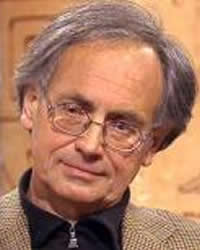Inauguration BEL
- October 1st, 2010
Inauguration BEL
Peter Fromherz

The interfacing of semiconductor chips with ion channels, nerve cells and brain tissue
Abstract:
The processes are studied that determine the interfacing between the elementary components of brain and computer. One goal is to develop hybrids that allow the study of information processing in neuronal networks. Another aim is to provide a basis for improved neuroprosthetic devices. Care is taken that electrochemical reactions are excluded to avoid any damage of hard and soft matter. (i) The nature of cell/chip contact is addressed with core-coat conductor models. (ii) Capacitors and transistors are fabricated with simple silicon chips and CMOS chips. (iii) The structure of cell/chip contacts is optically investigated on a nanometer and micrometer scale. (iv) The resistance of cell-chip contacts is probed by thermal noise. (v) The mechanism of capacitor stimulation and transistor recording is elucidated with recombinant ion channels. (vi) Stimulation and recording are characterized with nerve cells from snail and rat. (vii) Simple hybrids are implemented with two-way silicon chips. (viii) Rabbit retinae are attached to CMOS chips for stimulation. (ix) Brain slices are interfaced. Their dynamics is visualized at a high spatial resolution with CMOS chips. (x) Needle chips with capacitors and transistors are fabricated and tested in brain tissue.
Biography:
Peter Fromherz is a Director at the Max Planck Institute for Biochemistry, Munich (Department of Membrane and Neurophysics) and Professor for Biophysics in the Physics Department of the Technical University Munich. He completed his PhD in Physical Chemistry in 1969 at the University Marburg, worked for ten years at the Max Planck Institute for Biophysical Chemistry in Goettingen and became a full professor for Experimenal Physics at the University Ulm in 1981. Since 1994 he is a Scientific Member of the Max Planck Society and works in Munich on the electrical interfacing of neuronal systems and semiconductors and on fluorescent dyes as optical probes for neuronal activity. He is a member of the Academies of Science in Berlin and Heidelberg.
